Explain the conditions under which a bulb glows when it is connected by wires to a cell .
To explain the conditions under which a bulb glows when it is connected by wires to a cell, we can break it down into several key steps:
1. Understanding the Circuit Components:
- A basic circuit consists of a cell (battery), a bulb (light), and connecting wires.
- The cell provides electrical energy, while the bulb converts this energy into light.
2. Completing the Circuit:
- For the bulb to glow, the circuit must be complete. This means that there should be a continuous path for the electric current to flow.
- If there is a break in the circuit (e.g., a cut wire), the current cannot flow, and the bulb will not light up.
3. Connecting the Bulb to the Cell:
- The bulb has two terminals: one connected to the positive terminal of the cell and the other connected to the negative terminal.
- Both terminals of the bulb must be connected to the respective terminals of the cell for the bulb to glow.
4. Checking for Proper Connections:
- Ensure that the wires are securely connected to both the bulb and the cell.
- If either terminal of the bulb is not connected to the cell, the circuit is incomplete, and the bulb will not light up.
5. Current Flow:
- When the circuit is complete, electric current flows from the positive terminal of the cell, through the bulb, and back to the negative terminal of the cell.
- This flow of current is what causes the filament in the bulb to heat up and emit light.
Conclusion:
In summary, for a bulb to glow when connected to a cell, the circuit must be complete, both terminals of the bulb must be connected to the cell, and there must be a continuous path for the electric current to flow.
- A basic circuit consists of a cell (battery), a bulb (light), and connecting wires.
- The cell provides electrical energy, while the bulb converts this energy into light.
- For the bulb to glow, the circuit must be complete. This means that there should be a continuous path for the electric current to flow.
- If there is a break in the circuit (e.g., a cut wire), the current cannot flow, and the bulb will not light up.
- The bulb has two terminals: one connected to the positive terminal of the cell and the other connected to the negative terminal.
- Both terminals of the bulb must be connected to the respective terminals of the cell for the bulb to glow.
- Ensure that the wires are securely connected to both the bulb and the cell.
- If either terminal of the bulb is not connected to the cell, the circuit is incomplete, and the bulb will not light up.
- When the circuit is complete, electric current flows from the positive terminal of the cell, through the bulb, and back to the negative terminal of the cell.
- This flow of current is what causes the filament in the bulb to heat up and emit light.
In summary, for a bulb to glow when connected to a cell, the circuit must be complete, both terminals of the bulb must be connected to the cell, and there must be a continuous path for the electric current to flow.
Topper's Solved these Questions
- ELECTRICITY AND CIRCUITS BOOK - MTG IIT JEE FOUNDATIONCHAPTER - ELECTRICITY AND CIRCUITS EXERCISE - EXERCISE (Integer /Numberical /Value Type)
2 Videos
- ELECTRICITY AND CIRCUITS BOOK - MTG IIT JEE FOUNDATIONCHAPTER - ELECTRICITY AND CIRCUITS EXERCISE - OLYMPIAD /HOTS CORNER
15 Videos
- ELECTRICITY AND CIRCUITS BOOK - MTG IIT JEE FOUNDATIONCHAPTER - ELECTRICITY AND CIRCUITS EXERCISE - EXERCISE (Subjective Problems (Short Answer Type)
15 Videos
- FUN WITH MAGNETSBOOK - MTG IIT JEE FOUNDATIONCHAPTER - FUN WITH MAGNETSEXERCISE - Olympaid/HOTS Corner
15 Videos
Similar Questions
Knowledge Check
In which case does the bulb glow ?
A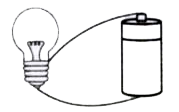 B
B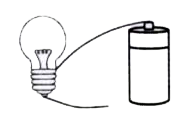 C
C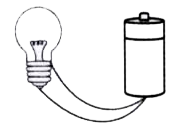 D
D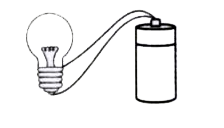
Assertion : Two electric bulbs of 50 and 100W are given. When connected in series 50W bulb glows more but When connected parallel 100W bulb glows more .
Reason : In series combination, power is directly proportional to the resistance of circuit. But in parallel combination, power is inversely proportional to the resistance of the circuit.AIf both assertion and reason are ture and reason is the correct explanation of assertion.BIf both assertion and reason are true but reason is not the correct explanation of assertion.CIf assertion is true but reason is false.DIf assertion and reason both are false.In the previous question which lamp will glow more brightly when they are in connected in series ?
ALamp having lower resistanceBLamp having higher resistanceCBoth the lampsDNone of the two lamps
In which case, bulb glows in the circuit.
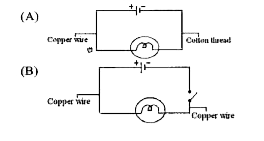
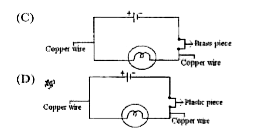
View SolutionWhy does an electric bulb does not glow even it is connected to the cell ?
View SolutionAssertion: Two electric bulbs of 50 and 100W. Are given. When connected in sereis 50W bulb glows more but when connected parallel 100 W bulb glows more.
Reason : In series combination, power is directly proportional to the resistance of circuit. but in parallel comb ination, power is inversely proportional to the resistance of the circuit.
View SolutionAnsh made an electric circuit by using a dry cell , two electric wires and one electric bulb . First , he connected one end of wire to the positive terminal and another end of wire to the negative terminal of the cell .Now , he connect the bulb to the wire which is connected with the negative terminal of the cell .Does bulb glow ?
View SolutionWhat is the thin wire In the bulb which glows when an electric current passes through It called?
View Solution
